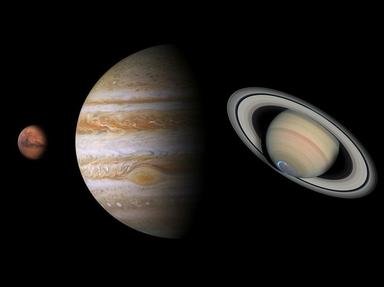Quiz Answer Key and Fun Facts
1. In nearly all of outer space, including our Solar System, smaller objects orbit larger objects. What term is used to describe the amount by which an object's orbit around another body deviates from a perfect circle?
2. There is one planet in the Solar System that takes longer to rotate on its axis (243 Earth days) than it does to complete a revolution around the Sun (225 Earth days). What is this planet, whose surface is obscured by clouds of sulfuric acid?
3. Personifying horror, this moon could certainly classify as a space oddity due to its irregular shape. Orbiting closer to its planet than any other moon at just 6,000 km (3,700 mi), which moon was discovered in 1877 by Asaph Hall and is named after a Greek god who was the son of Ares and Aphrodite?
4. In the outer area of the Asteroid Belt is a group of about 1,100 asteroids that oddly exhibit a 2:3 orbital resonance with Jupiter. Sharing its name with the main character in the television show "Ugly Betty", what is this group of asteroids?
5. Our next space oddity is a moon of Saturn that, with a diameter of just 396 km (246 mi), is the smallest astronomical body rounded in shape because of self-gravitation. What is this moon that has a giant impact crater named Herschel?
6. Compared to the other terrestrial planets in the Solar System, Earth is certainly an oddity. What comprises 70% of the surface of Earth that is not prevalent on any of the other planets?
7. The extreme differences in size and composition of the planets within our Solar System is certainly an oddity. Which of the following is a true statement regarding the mass of the planets?
8. The rings of Saturn are one of its most distinctive features. Oddly it wasn't until 2008 that evidence was found of a planetary moon having a ring system. What is the name of this ringed moon of Saturn that shares its name with a Greek goddess who was the wife of Cronus?
9. In astronomy there is a term that is used to describe the angle between a planet's equatorial plane and its orbital plane. What is this metric for which the Earth measures 23°, Uranus 98°, and Venus an extreme 177°?
10. Possibly the oddest objects in the Solar System are comets. Typically composed of gas, dust, and water ice, when a comet passes relatively close to the Sun part of it goes through sublimation creating an envelope around its nucleus. What is the name for this envelope that makes the comet appear fuzzy?
Source: Author
Triviaballer
This quiz was reviewed by FunTrivia editor
rossian before going online.
Any errors found in FunTrivia content are routinely corrected through our feedback system.


